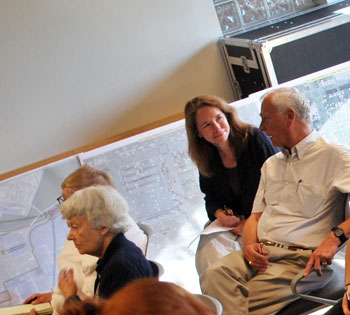Prices to Get Tweaked as Parking Deck Opens
Ann Arbor Downtown Development Authority board meeting (May 2, 2012): The one action item on the board’s agenda was a resolution directing its operations committee to start applying demand-management principles to the pricing for permits in Ann Arbor’s public parking system. The resolution, which passed unanimously, notes that the goal of the pricing strategy is to attract patrons to those structures that are located farther away from the University of Michigan campus.

Ann Arbor Downtown Development Authority board members Roger Hewitt (left) and Keith Orr. They're examining a Girl Scout badge created for assisting in the Downtown Blooms event. The car on the wall in the background is a mockup of the planned wayfinding system for the levels of the new underground parking structure, anticipated to open by mid-July. (Photos by the writer.)
One of those structures farther west of the campus is the new underground parking garage on South Fifth Avenue, which is nearing completion. The garage, which the DDA is currently calling the “Library Lane” parking structure, is now expected to open by the time the art fairs begin, which this year fall on July 18–21. South Fifth Avenue between Liberty and William is expected to re-open by Memorial Day.
A characterization of that timing as “on schedule” was disputed during public commentary by Ali Ramlawi, owner of the Jerusalem Garden restaurant. Jerusalem Garden is adjacent to the construction site. Ramlawi noted that the structure was originally due to be completed by August 2011.
The future use of the top of the underground garage was the subject of public commentary from advocates who’d like to see it used as a green plaza. That suggestion was met with remarks from mayor John Hieftje, who sits on the DDA board, with a description of his expectation that three major parcels would soon be incorporated into the city’s park system – 721 N. Main, 415 W. Washington, and the MichCon property (located between the Amtrak rail station and the Huron River near the Broadway bridges). Hieftje’s point was that the additional financial burden for the maintenance of those parcels as parks might impact the city’s ability to add a downtown green plaza to the park system.
Requests for better information about the parking system and suggestions for disseminating information about the availability of open parking spaces were topics of additional public commentary.
Although it was not an action item, the board discussed a draft policy on supporting “brownfield” projects – a policy prompted by discussions at the board’s partnerships committee over the last few months. [.pdf of draft DDA brownfield policy]
The committee has been discussing a proposal by Dan Ketelaar for support of a proposed development at 618 S. Main, which received a positive recommendation from the Ann Arbor planning commission on Jan. 19, 2012. If the project moves forward, the 7-story building would include 190 units for 231 bedrooms, plus two levels of parking for 121 vehicles. Ketelaar has estimated that the tax on the increment between the current valuation of the property and the final built project would yield around $250,000 a year in TIF (tax increment finance) revenue to the DDA. If adopted as it’s currently worded in the draft, the formula in the policy would translate into up to $625,000 of support for 618 S. Main.
The board also received updates on the third-quarter financial statements for the DDA, as well as an update on the Connection William Street planning project. [Full Story]




